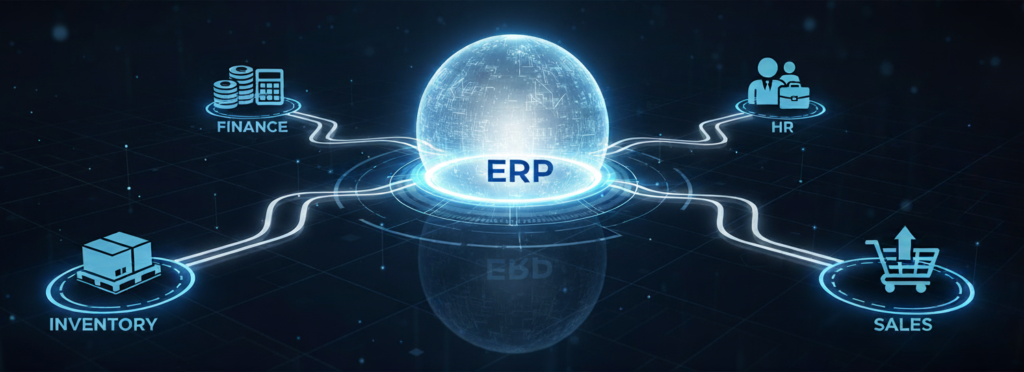In today’s fiercely competitive business environment, organizations require a comprehensive understanding of their performance to make informed choices. Key Performance Indicators (KPIs) serve as the cornerstone of this understanding. These quantifiable metrics offer a window into a company’s progress towards its strategic objectives.Businesses may gain important insights into their operations by utilizing the sophisticated KPI monitoring and analysis capabilities of NetSuite, a potent Enterprise Resource Planning (ERP) platform.
This blog dives deep into the world of NetSuite KPIs, exploring their significance, guiding you through the selection process, and showcasing essential KPIs across various business functions. We will also delve into the numerous advantages of data-driven decision making facilitated by NetSuite’s KPI functionalities.

Choosing the right KPIs is crucial for effective performance measurement
Selecting the Optimal KPIs for Your Business
The selection of KPIs should be a strategic endeavor that aligns with your unique business objectives and industry best practices. Here are some key considerations to keep in mind during the selection process:
- Business Goals: Identify your overarching strategic goals and translate them into actionable KPIs that track progress towards those goals.
- Departmental Objectives: Define KPIs specific to each department, ensuring alignment with the overall business strategy.
- Data Availability: Choose KPIs for which data is readily accessible within NetSuite or readily integrable from other systems.
- Actionability: Prioritize KPIs that provide actionable insights informing process improvements or strategic adjustments.
By adhering to these guidelines, businesses can ensure their chosen KPIs deliver a clear picture of their performance and guide them towards their strategic objectives.
Essential NetSuite KPIs to Consider for Holistic Performance Analysis
NetSuite offers a comprehensive suite of functionalities, enabling businesses to track performance across various areas.The following is a breakdown of key performance indicators (KPIs) that you can use in NetSuite, broken down by business function:
Revenue and Sales
- Sales Cycle Length: This metric tracks the average time taken to convert leads into paying customers. A shorter sales cycle length indicates a more efficient sales process.
- Customer Acquisition Cost (CAC): This metric measures the overall expenditure required to acquire a new customer. Businesses strive to minimize CAC(Customer acquisition cost) while maximizing customer lifetime value.
- Average Deal Size: This metric analyzes the average revenue generated per customer transaction. A higher average deal size indicates increased sales effectiveness.
- Sales Win Rate: This metric tracks the percentage of successfully closed deals compared to the total opportunities pursued. A higher win rate suggests a robust sales pipeline and effective sales strategies.
Client Support
- Customer Satisfaction Score (CSAT): This metric measures customer satisfaction with service interactions. A high CSAT indicates a positive customer experience.
- First Contact Resolution (FCR): This metric tracks the percentage of customer issues resolved during the initial interaction. A higher FCR signifies efficient customer service resolution.
- Average Resolution Time (ART): This metric measures the average time taken to resolve customer issues. A lower ART indicates a more responsive customer service team.
- Net Promoter Score (NPS): This metric gauges customer loyalty based on their willingness to recommend your product or service. A high NPS suggests a strong customer base and potential for organic growth.
Inventory Control
- Inventory Turnover Ratio: This metric analyzes the number of times inventory is sold and replaced within a specific period. A higher inventory turnover ratio indicates efficient inventory management.
- Stockout Rate: This metric measures the percentage of customer orders that cannot be fulfilled due to stock unavailability. A low stockout rate signifies optimal inventory levels.
- Inventory Carrying Cost: This metric tracks the financial burden associated with holding inventory. Businesses strive to minimize carrying costs while maintaining sufficient stock levels.
- Days Sales of Inventory (DSI): This metric measures the average number of days it takes to sell the existing inventory. A lower DSI suggests efficient inventory management practices. Revenue earned. A higher profit margin signifies operational efficiency and cost-effectiveness.
- Return on Investment (ROI): This metric measures the financial return achieved on a specific investment. Businesses prioritize investments with a high ROI to maximize their financial gains.
- Cash Flow: This metric tracks the inflow and outflow of cash within a business. Maintaining positive cash flow ensures an organization’s ability to meet its financial obligations and support ongoing operations.
Functional Effectiveness
- Order Processing Time: This metric measures the average time taken to process customer orders. A shorter processing time translates to faster fulfillment and improved customer satisfaction.
- Production Cycle Time: This metric tracks the average time taken to manufacture a product. Reduced production cycle time signifies efficient production processes and faster product delivery.
- Defect Rate: This metric measures the percentage of products or services that do not meet quality standards. A lower defect rate indicates robust quality control procedures and a higher level of customer satisfaction.
- Employee Productivity: This metric evaluates the output generated by employees per unit of time. Increased employee productivity translates to higher production output and improved operational efficiency.
These are just a few examples, and the specific KPIs you choose will depend on your unique business model and strategic goals.
Effectively Analyzing and Monitoring KPIs with NetSuite
NetSuite’s robust reporting and analytics capabilities empower businesses to gain deeper insights into their performance through effective KPI monitoring and analysis. Here’s how:
- Pre-built Dashboards: Utilize pre-built dashboards for various business functions to gain a quick snapshot of key performance metrics. These dashboards can be customized to display the most relevant KPIs for your specific needs.
- Ad-hoc Reporting: Create personalized reports that are customized to your requirements and schedule. This makes it possible to examine performance data in greater detail and spot patterns or areas that need more research.
- Drill-Down Capabilities: NetSuite allows you to drill down into specific data points within a report for a more granular analysis. This capability helps you uncover the root causes of performance issues and identify opportunities for improvement.
- Real-Time Visibility: Gain real-time insights into your business performance with NetSuite’s robust data visualization tools. This allows for proactive decision-making and course correction as needed.
Integration with External Data Sources: Gather and evaluate data from several sources in one place by integrating NetSuite with other business platforms. This comprehensive perspective of your data gives you the ability to make wiser judgments.
Businesses can turn raw data into actionable insights that inform strategic decision-making and enhance overall performance by utilizing these functionalities.
Advantages of Making Decisions Based on Data
Data-driven decision making offers numerous advantages for businesses of all sizes. Here are some key benefits to consider:
- Improved Strategic Planning: Businesses can make well-informed decisions about future growth plans, investment strategies, and resource allocation by utilizing KPI data.
- Enhanced Operational Efficiency: Data-driven insights can help identify areas for process improvement, leading to increased efficiency and cost savings.
- Stronger Customer Relationships: By tracking customer service KPIs, businesses can identify areas for improvement and enhance the overall customer experience, fostering stronger customer relationships.
- Increased Profitability: Data-driven decision making empowers businesses to make strategic choices that optimize resource allocation, minimize costs, and maximize profitability.
- Competitive Advantage: Through utilizing data to obtain insights into consumer behavior and market trends, companies may acquire a competitive edge and remain ahead of the curve.
In today’s dynamic business environment, data-driven decision making is no longer a luxury; it’s a necessity. NetSuite, with its comprehensive KPI monitoring and analysis capabilities, empowers businesses to harness the power of data and make informed choices that drive success.
KPIs serve as the foundation for effective performance measurement. By selecting the right KPIs and leveraging NetSuite's powerful functionalities, businesses can gain valuable insights into their operations and make data-driven decisions that propel them towards achieving their strategic objectives.
NetSuite empowers businesses to transform from a data-rich to an insights-driven organization, paving the way for sustainable growth and long-term success.







